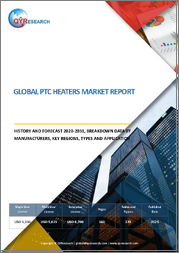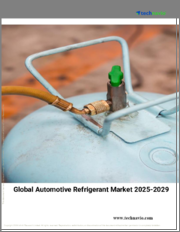
|
시장보고서
상품코드
1628276
자동차 공조 시장 기회, 성장 촉진요인, 산업 동향 분석, 예측(2025-2034년)Automotive Climate Control Market Opportunity, Growth Drivers, Industry Trend Analysis, and Forecast 2025 - 2034 |
||||||
자동차 공조 세계 시장은 2024년에 115억 달러로 평가되며 2025년부터 2034년까지 연평균 12.9%의 CAGR로 견고하게 성장할 것으로 예상됩니다.
이러한 성장의 주요 요인은 전기자동차(EV)의 보급이 증가하고 있으며, EV는 배터리 성능을 최적화하고 안전을 보장하기 위해 첨단 공조 제어 시스템을 필요로 합니다. 기존 자동차와 달리 EV는 정밀한 열 관리 솔루션에 크게 의존하기 때문에 이 시장에서는 특수 시스템에 대한 수요가 증가하고 있습니다.
또한, 차량 내 경험을 중시하는 경향이 강화되고 있는 것도 시장 확대에 큰 역할을 하고 있습니다. 소비자들은 현재 정확한 온도 조절, 공기질 모니터링, 맞춤형 설정과 같은 최신 편의 기능을 갖춘 자동차를 원하고 있습니다. 이러한 소비자의 요구에 부응하기 위해 자동차 제조사들은 멀티존 시스템, 공기청정기 등 혁신적인 공조 제어 기술을 통합하여 소비자의 선호도를 충족시키고 있습니다. 이러한 커스터마이징과 편의성에 대한 관심 증가는 첨단 공조 솔루션 시장을 크게 견인할 것으로 예상됩니다.
차종별로 시장은 승용차와 상용차로 구분됩니다. 승용차는 2024년 시장 점유율의 약 70%를 차지했으며, 이는 개인 이동수단의 편안함과 편의성에 대한 소비자의 기대치가 높아진 것을 반영합니다. 신흥국을 중심으로 한 세계 승용차 생산의 급격한 증가는 이러한 수요에 박차를 가하고 있습니다. 또한, 커넥티드카 및 자율주행차 기술의 발전은 적응적이고 개인화된 차량 내 환경을 조성할 수 있는 공조 시스템의 채택을 촉진하여 이 부문의 성장을 더욱 촉진하고 있습니다.
| 시장 범위 | |
|---|---|
| 시작 연도 | 2024년 |
| 예측 연도 | 2025-2034년 |
| 시작 금액 | 115억 달러 |
| 예상 금액 | 384억 달러 |
| CAGR | 12.9% |
최종 용도에 따라 시장은 주문자상표부착생산(OEM)과 애프터마켓으로 구분되며, OEM은 첨단 공조 제어 시스템을 차량 제조에 직접 통합할 수 있기 때문에 2024년 시장 점유율이 64%로 압도적입니다. 이러한 공장 설치형 솔루션은 우수한 성능을 제공하고, 엄격한 규제를 준수하며, 에너지 효율적이고 고품질의 기능을 원하는 소비자의 요구에 부합합니다. 자동차 제조업체들이 경쟁력을 유지하기 위해 혁신적인 솔루션을 우선시함에 따라, 이 경쟁 부문은 안정적인 성장이 예상됩니다.
미국 자동차 공조 시장은 자동차 산업의 호조와 첨단 자동차 기술에 대한 수요 증가에 힘입어 2034년까지 100억 달러 규모에 달할 것으로 예상됩니다. 배출가스 저감 및 에너지 효율에 대한 규제 요건은 제조업체들이 첨단 공조 제어 시스템을 채택하도록 유도하고 있습니다. 이러한 추세는 첨단 공조 제어가 필요한 자동차에 대한 선호와 함께 이 지역을 시장 확대의 주요 요인으로 꼽을 수 있습니다.
목차
제1장 조사 방법과 조사 범위
제2장 주요 요약
제3장 업계 인사이트
- 생태계 분석
- 주문자상표부착생산(OEM)
- 기술 프로바이더
- 부품 공급업체
- 최종사용자
- 공급업체 상황
- 이익률 분석
- 기술 혁신 상황
- 비용 내역 분석
- 특허 상황
- 주요 뉴스와 이니셔티브
- 규제 상황
- 영향요인
- 성장 촉진요인
- 전기자동차 보급
- HVAC 시스템의 기술적 진보
- 세계의 자동차 생산 증가
- 가처분 소득과 자동차 소유율 상승
- 업계의 잠재적 리스크와 과제
- 높은 개발·설치 비용
- 저가격차에 대한 채택이 한정적
- 성장 촉진요인
- 성장 가능성 분석
- Porters 분석
- PESTEL 분석
제4장 경쟁 구도
- 소개
- 기업 점유율 분석
- 경쟁 포지셔닝 매트릭스
- 전략 전망 매트릭스
제5장 시장 추정과 예측 : 기술별, 2021-2034년
- 주요 동향
- 자동
- 수동
제6장 시장 추정과 예측 : 차종별, 2021-2034년
- 주요 동향
- 승용차
- 해치백
- 세단
- SUV차
- 기타
- 상용차
- 트럭
- 버스
제7장 시장 추정과 예측 : 연료별, 2021-2034년
- 주요 동향
- 가솔린
- 디젤
- 올 EV
- PHEV
- HEV
제8장 시장 추정과 예측 : 구성요소별, 2021-2034년
- 주요 동향
- 컴프레서
- 콘덴서
- 증발기
- 제어 패널
- 센서
- 기타
제9장 시장 추정과 예측 : 용도별, 2021-2034년
- 주요 동향
- OEM
- 애프터마켓
제10장 시장 추정과 예측 : 지역별, 2021-2034년
- 주요 동향
- 북미
- 미국
- 캐나다
- 유럽
- 영국
- 독일
- 프랑스
- 스페인
- 이탈리아
- 러시아
- 북유럽
- 아시아태평양
- 중국
- 인도
- 일본
- 한국
- 뉴질랜드
- 동남아시아
- 라틴아메리카
- 브라질
- 멕시코
- 아르헨티나
- 중동 및 아프리카
- 아랍에미리트
- 남아프리카공화국
- 사우디아라비아
제11장 기업 개요
- Behr Hella Service
- BorgWarner
- Continental
- Denso
- Eberspacher
- Johnson Electric
- Hanon Systems
- Keihin
- Mahle
- Marelli
- Mitsubishi Heavy Industries
- Modine
- Nissens
- Panasonic
- Sanden
- Tata AutoComp Systems
- Thermoking
- Valeo
- Visteon
- Zexel
The Global Automotive Climate Control Market, valued at USD 11.5 billion in 2024, is anticipated to grow at a robust CAGR of 12.9% from 2025 to 2034. This growth is primarily driven by the rising adoption of electric vehicles (EVs), which require advanced climate control systems to optimize battery performance and ensure safety. Unlike traditional vehicles, EVs rely heavily on precise thermal management solutions, boosting the demand for specialized systems in this market.
The increasing emphasis on enhancing in-cabin experiences also plays a significant role in market expansion. Consumers are now seeking vehicles equipped with modern comfort features like accurate temperature control, air quality monitoring, and personalized settings. As demand for superior comfort continues to rise, automakers are integrating innovative climate control technologies, including multi-zone systems and air purifiers, to cater to consumer preferences. This growing focus on customization and convenience is expected to significantly boost the market for advanced climate solutions.
In terms of vehicle types, the market is segmented into passenger cars and commercial vehicles. Passenger cars held approximately 70% of the market share in 2024, reflecting heightened consumer expectations for comfort and convenience in personal transportation. The surge in passenger vehicle production worldwide, particularly in emerging economies, has fueled this demand. Additionally, advancements in connected and autonomous vehicle technologies drive the adoption of climate systems capable of creating adaptive and personalized cabin environments, further bolstering the segment's growth.
| Market Scope | |
|---|---|
| Start Year | 2024 |
| Forecast Year | 2025-2034 |
| Start Value | $11.5 Billion |
| Forecast Value | $38.4 Billion |
| CAGR | 12.9% |
Based on end-use, the market is categorized into original equipment manufacturers (OEMs) and aftermarket. OEMs dominated with a 64% market share in 2024 due to their ability to incorporate advanced climate control systems directly into vehicle manufacturing. These factory-installed solutions offer superior performance, comply with stringent regulations, and align with consumer demand for energy-efficient and high-quality features. As automakers prioritize innovative solutions to remain competitive, the OEM segment is expected to witness steady growth.
The U.S. automotive climate control market is poised to reach USD 10 billion by 2034, supported by a strong automotive sector and increasing demand for advanced vehicle technologies. Regulatory requirements emphasizing emissions reduction and energy efficiency pushing manufacturers to adopt cutting-edge climate control systems. These trends, combined with a preference for vehicles that require advanced climate management, position the region as a key contributor to market expansion.
Table of Contents
Chapter 1 Methodology & Scope
- 1.1 Research design
- 1.1.1 Research approach
- 1.1.2 Data collection methods
- 1.2 Base estimates and calculations
- 1.2.1 Base year calculation
- 1.2.2 Key trends for market estimates
- 1.3 Forecast model
- 1.4 Primary research & validation
- 1.4.1 Primary sources
- 1.4.2 Data mining sources
- 1.5 Market definitions
Chapter 2 Executive Summary
- 2.1 Industry 360° synopsis, 2021 - 2034
Chapter 3 Industry Insights
- 3.1 Industry ecosystem analysis
- 3.1.1 Original Equipment Manufacturers (OEMs)
- 3.1.2 Technology providers
- 3.1.3 Component suppliers
- 3.1.4 End users
- 3.2 Supplier landscape
- 3.3 Profit margin analysis
- 3.4 Technology & innovation landscape
- 3.5 Cost breakdown analysis
- 3.6 Patent landscape
- 3.7 Key news & initiatives
- 3.8 Regulatory landscape
- 3.9 Impact forces
- 3.9.1 Growth drivers
- 3.9.1.1 Rising adoption of electric vehicles
- 3.9.1.2 Technological advancements in HVAC systems
- 3.9.1.3 Growing automotive production globally
- 3.9.1.4 Rising disposable income and vehicle ownership
- 3.9.2 Industry pitfalls & challenges
- 3.9.2.1 High development and installation costs
- 3.9.2.2 Limited adoption in low-cost vehicles
- 3.9.1 Growth drivers
- 3.10 Growth potential analysis
- 3.11 Porter's analysis
- 3.12 PESTEL analysis
Chapter 4 Competitive Landscape, 2024
- 4.1 Introduction
- 4.2 Company market share analysis
- 4.3 Competitive positioning matrix
- 4.4 Strategic outlook matrix
Chapter 5 Market Estimates & Forecast, By Technology, 2021-2034, ($Mn, Units)
- 5.1 Key trends
- 5.2 Automatic
- 5.3 Manual
Chapter 6 Market Estimates & Forecast, By Vehicle, 2021-2034, ($Mn, Units)
- 6.1 Key trends
- 6.2 Passenger cars
- 6.2.1 Hatchback
- 6.2.2 Sedan
- 6.2.3 SUV
- 6.2.4 Others
- 6.3 Commercial vehicle
- 6.3.1 Trucks
- 6.3.2 Bus
Chapter 7 Market Estimates & Forecast, By Fuel, 2021-2034, ($Mn, Units)
- 7.1 Key trends
- 7.2 Gasoline
- 7.3 Diesel
- 7.4 All-electric
- 7.5 PHEV
- 7.6 HEV
Chapter 8 Market Estimates & Forecast, By Component, 2021-2034, ($Mn, Units)
- 8.1 Key trends
- 8.2 Compressors
- 8.3 Condensers
- 8.4 Evaporators
- 8.5 Control panels
- 8.6 Sensors
- 8.7 Others
Chapter 9 Market Estimates & Forecast, By End-Use, 2021-2034, ($Mn, Units)
- 9.1 Key trends
- 9.2 OEM
- 9.3 Aftermarket
Chapter 10 Market Estimates & Forecast, By Region, 2021 - 2034 ($Mn, Units)
- 10.1 Key trends
- 10.2 North America
- 10.2.1 U.S.
- 10.2.2 Canada
- 10.3 Europe
- 10.3.1 UK
- 10.3.2 Germany
- 10.3.3 France
- 10.3.4 Spain
- 10.3.5 Italy
- 10.3.6 Russia
- 10.3.7 Nordics
- 10.4 Asia Pacific
- 10.4.1 China
- 10.4.2 India
- 10.4.3 Japan
- 10.4.4 South Korea
- 10.4.5 ANZ
- 10.4.6 Southeast Asia
- 10.5 Latin America
- 10.5.1 Brazil
- 10.5.2 Mexico
- 10.5.3 Argentina
- 10.6 MEA
- 10.6.1 UAE
- 10.6.2 South Africa
- 10.6.3 Saudi Arabia
Chapter 11 Company Profiles
- 11.1 Behr Hella Service
- 11.2 BorgWarner
- 11.3 Continental
- 11.4 Denso
- 11.5 Eberspacher
- 11.6 Johnson Electric
- 11.7 Hanon Systems
- 11.8 Keihin
- 11.9 Mahle
- 11.10 Marelli
- 11.11 Mitsubishi Heavy Industries
- 11.12 Modine
- 11.13 Nissens
- 11.14 Panasonic
- 11.15 Sanden
- 11.16 Tata AutoComp Systems
- 11.17 Thermoking
- 11.18 Valeo
- 11.19 Visteon
- 11.20 Zexel



















